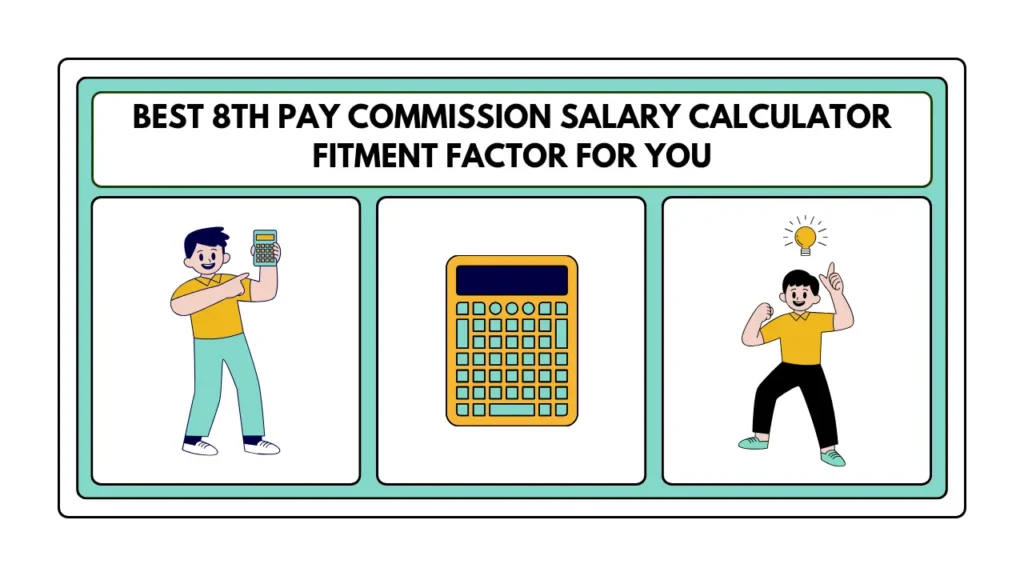Estimate your 8th Pay Commission salary hike! Understand the vital Fitment Factor (1.83x to 2.86x speculation), the new salary calculation formula, and implementation date.

Estimated 8th Pay Commission Salary Calculator
*Dearness Allowance (DA) is assumed to be zero (merged with Basic Pay) for this simplified estimation.
For over 50 lakh Central Government employees and 65 lakh pensioners, the 8th Pay Commission represents one of the most significant financial events of the decade. Following the decennial pattern, this commission is expected to usher in a comprehensive revision of pay, allowances, and pensions, providing a much-needed boost to combat rising inflation and cost of living.
Also Read: Delhi Circle Rate Revision Calculator 2025-26: Your Essential Guide & Calculator
While the official recommendations are still eagerly awaited, the most critical number everyone is speculating about is the Fitment Factor. This single multiplier is the cornerstone of the new pay structure, directly dictating the jump from your current 7th Pay Commission Basic Pay to your revised 8th CPC Basic Pay.
What is the Fitment Factor and Why Does it Matter?
The Fitment Factor is essentially a numerical multiplier applied to an employee's existing basic pay (including Grade Pay, where applicable) to determine their new, revised basic pay under the new Pay Commission structure.
Revised Basic Pay=Current Basic Pay×Fitment Factor
This factor is paramount because the entire salary structure—including the Dearness Allowance (DA), House Rent Allowance (HRA), and Travel Allowance (TA)—is calculated as a percentage of the Basic Pay. A higher Fitment Factor means a proportionally higher Basic Pay, leading to a substantial overall increase in the take-home salary and pension amount.
In the 7th Pay Commission, the government adopted a uniform fitment factor of 2.57x for all employees, which led to a minimum basic pay increase from ₹7,000 to ₹18,000.
8th Pay Commission Fitment Factor: The Current Speculations
With the commission's implementation expected to be effective from January 1, 2026, although the actual rollout might be delayed until late 2026 or early 2027, market analysts and employee federations are presenting a broad range of expected fitment factors.
The speculation for the 8th Pay Commission Fitment Factor generally falls into the following key ranges:
| Fitment Factor Range | Minimum Basic Pay (Projected from ₹18,000) | Potential Impact |
| Conservative Estimate (1.83x) | ₹32,940 | Reflects fiscal prudence and a lower-than-expected hike. |
| Analyst Median (2.28x) | ₹41,040 | A widely cited moderate multiplier, balancing employee demand and government finances. |
| High Expectation (2.86x) | ₹51,480 | A more optimistic factor that aligns with a higher percentage hike (30%+). |
| Employee Demand (3.68x) | ₹66,240 | Reflects the demand for full compensation against inflation using the Aykroyd formula. |
This wide range highlights the significant financial impact of the final number. A Fitment Factor of 2.86x is often cited as the aspirational goal to ensure the real value of wages keeps pace with the current economic landscape.
How to Calculate Your Estimated 8th CPC Salary
An 8th Pay Commission Salary Calculator is an essential tool for employees to estimate their revised income. While official figures will ultimately prevail, you can use the speculated fitment factors to get a realistic estimate.
Here is the general formula used for an approximation:
- Calculate New Basic Pay: New Basic Pay=Current 7th CPC Basic Pay×Expected Fitment Factor (e.g., 2.28)
- Calculate New Gross Salary: New Gross Salary=New Basic Pay+HRA+TA
- Crucial Note on DA: Upon the implementation of a new Pay Commission, the existing Dearness Allowance (DA) component is merged with the Basic Pay, and the DA percentage is reset to 0%. Therefore, your calculation should not include the old DA component.
- HRA & TA: The House Rent Allowance (HRA) and Travel Allowance (TA) percentages (which vary by city type: X-City 27%, Y-City 18/20%, Z-City 9/10%) are applied to the New Basic Pay. The 8th Pay Commission is also likely to revise these percentages upward.
Example Calculation (Using an Estimated Fitment Factor of 2.28x)
Let's consider an employee in a Y-Class City with a current basic pay of ₹40,000:
- New Basic Pay: ₹40,000×2.28=₹91,200
- HRA (Estimated 20%): ₹91,200×20%=₹18,240
- Estimated Gross Salary: ₹91,200+₹18,240+TA (Revised)≈∗∗₹1,09,440** (excluding TA and deductions).
The difference between the high and low-end fitment factors (1.83x vs 2.86x) for a ₹40,000 basic pay can be ₹73,200 versus ₹1,14,400, illustrating why the final announced factor is so vital.
The Road Ahead: Why Timing Matters
The expectation for the new pay scales to be implemented from January 1, 2026, is based on the 10-year gap between the 7th and 8th Pay Commissions. However, the process of forming the commission, gathering data, and submitting a report is extensive. If the implementation is delayed, as has happened historically, employees will receive a significant amount in arrears from the effective date.
The final determination of the Fitment Factor will be a balancing act between compensating employees fairly for inflation and the government's fiscal capacity. By tracking the latest official announcements and using the estimated factors in a salary calculator, you can stay prepared for the massive financial revision on the horizon.














